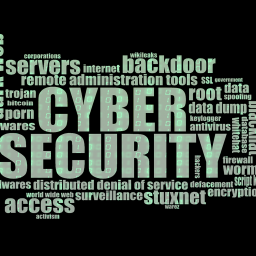
Cyber Security for Business: Back to Basics
How many times have you put off a job because it is too difficult or you are unsure where to begin?
Cyber security may be rather scary for business owners. Despite repeated warnings that it should be a high priority for their company, it gets pushed further and farther down the to-do list because they anticipate a tough time handling it and would rather focus on things that are within their comfort zone and give quick gains.
Many of us are convinced by the complexity of cyber security to ignore it, until we can’t. Nevertheless, waiting for an actual cyber attack to hit your company is not an efficient security plan.
In this post, we’ll help you understand the fundamentals of cyber security for your organization, cut through the jargon, and provide specific steps you can confidently take to make your firm more safe.
What is cyber security anyway?
Simply put, cyber security is the safeguarding of your networks, devices, and data. Every year, as our commercial world gets more digitalized, cyber attacks, which often include data theft for financial gain, become more common and sophisticated.
There are numerous ways to defend your systems and data against these types of assaults, but it is critical for organizations to stay on top of this by continuously monitoring and correcting their vulnerabilities.
Of all, the way we utilize technology nowadays is quite sophisticated, making it more difficult to cover all possible access points for hackers and ensuring they are adequately safeguarded.
What are some of the most common cyber threats for businesses?
Hackers, like burglars, might use a variety of tactics to gain unauthorized access, such as picking a lock, climbing in through a window, or just busting down a flimsy door.
Cyber security is about detecting these ways and making them useless, or at least far more difficult to execute. You might increase the number of locks on your door, barricade the windows, or install a security camera. There are numerous parallels between the worlds of physical security and cyber security.
1. Phishing:
For many years, phishing has been the most popular type of assault against businesses. In 2022, these social engineering hacks were responsible for 83% of cyber incidents.
You probably get a lot of spam emails every day, and it’s obvious they’re spam – in fact, your email software will probably recognize them for you and send them to your junk folder before you even have to look at them.
But, cyber attackers have become more sophisticated, and a phishing email can be so convincing that it would take a long, hard look to detect anything strange. Messages can look to be from someone you know and trust, even a colleague, but it is this trust that hackers rely on, because we are most likely to make mistakes when we are trusting.
2. Malware:
This is a fancy title for software that causes harm to your devices or network. You may have also heard the names viruses, worms, and trojans. It is frequently used in conjunction with other assaults such as phishing, in which a clicked link may release malware into your systems, rendering devices useless or tampering with sensitive data.
Ransomware is one of the most alarming types of malware affecting businesses right now. As the name implies, this type of malware is employed by attackers to seize control of data and keep it hostage for a ransom. While it is strongly advised that victims should not pay the ransom, many businesses do in order to recover what has been stolen and restore operations. Despite compensating the attackers, these people frequently never see their data again.
3. Man-in-the-Middle:
These attacks typically include a hacker lurking in the shadows, waiting to intercept a user’s data, such as when they type it into an application. An attacker can employ a variety of spoofing techniques to deceive the user into trusting a specific URL, network, or service. The attacker can then harvest and decrypt the user’s information.
Consider the attacker to be your postman, opening and reading your mail rather than delivering it through your mailbox.
4. Distributed Denial-of-Service:
Doesn’t that sound like a mouthful? These assaults are designed to overwhelm your devices and network by flooding a server with traffic, making real users’ access more difficult.
One of the greatest DDoS attacks on record was recorded in early 2020, when AWS, Amazon’s Cloud services provider, was overwhelmed with 2.3 terabytes per second of online traffic. To put this in context, this is just under half of all daily traffic on BT’s UK network.
Typically, the attacks are motivated by factors other than money; for example, a hacktivist (a person who gains illegal access to computer files or networks in order to achieve social or political purposes) making a statement or an irate ex-employee wishing to cause chaos.)
There are numerous more tools and tactics that hackers employ to carry out their assaults, and many of them may be used in tandem, as seen here.
But why should we be concerned about these threats? To properly comprehend why cyber security is crucial, it is necessary to thoroughly comprehend the impact that cyber incidents can have on an organization.
The following are some of the most common concerns that arise as a result of a cyber attack:
Damaged reputation:
Harm to brand reputation, which may damage investor interest and cause you to lose your competitive position.
Regulatory fines:
If consumer data is mishandled, fines of up to 4% of yearly revenue may be imposed.
Legal trouble:
Legal concerns may arise if confidential data and contracts are disclosed and proper procedures are not taken in the aftermath of an occurrence.
Recovery costs:
Costs associated with responding to a breach, such as cyber security investigations, public relations, and legal counsel.
Insurance suffers:
Insurance premiums will rise as a result of a breach since your company will appear less safe.
Loss of client trust:
Clients, business opportunities, and revenue are all lost when confidential contracts/data are disclosed.
Affected employees:
Employees could be fired if contract details and salaries are disclosed.
Business disruption:
Disruption to business operations, resulting in operational downtime that may harm revenue.
Stolen property:
Stolen intellectual property, such as product designs, business strategy, and technology, is frequently kept in the Cloud.
Drops in market value:
According to studies, breached organizations face a temporary loss in market value of roughly 3.5% following an occurrence.
So, now that you have a better understanding of the types of dangers your organization faces and the damage they can cause, let’s move on to the important part: implementing the correct kinds of solutions to fight these threats.
Building a cyber aware workforce
In the cyber war, your people are your most powerful weapon. Given that the majority of breaches are caused by human error, it stands to reason that security efforts should be aimed towards reducing the likelihood of these errors occurring.
Cyber awareness is not a one-time event; it must be maintained on a continuous basis, but it does not have to be difficult. Employees can benefit from regular cyber training sessions to be informed about current dangers and what they can do to protect themselves and their organizations.
With phishing being the most common attack vector, it’s also a good idea to test staff on occasion with bogus phishing email campaigns and see how they react. Numerous businesses offer this service at a low rate; here are our best choices in the UK.
You should also incorporate staff in your crisis response strategy so that any damage is minimized. What will they do if they come across something suspicious? The NCSC’s ‘Exercise in a Box’ is a useful online tool for practicing your company’s response to a cyber attack.
Password protection
What is associated with a cyber-aware workforce? Passwords that are difficult to guess.
Many of us make the mistake of choosing a password that is simple to remember – the last thing you want is for your busy day to be disrupted because your memory fails you. Yet what is simple for us is simple for the hackers.
Weak passwords are frequently the cause of a breach, therefore this is a simple issue that you can and should address with your personnel. A simple password policy is a smart method to codify your password expectations and security standards, and it can be presented with each employee throughout their onboarding process.
The following are some common password best practices to include in your policy:
- Most will demand a strong password to be at least 8 characters long.
- Avoid guessable terms and phrases: as much as you may want to, passwords should not include obvious personal information such as your birth date or street name. You might also give a list of commonly used passwords that your employees should never use.
- Include the following special characters and numbers: Changing the characters in your passwords might make them far more difficult to hack.
- Passwords should never be shared or reused: If a hacker gains access to one account or application, they can quickly gain access to others.
Using multi-factor authentication (MFA) whenever possible is also critical for optimal password health. This requires an additional step, such as a code texted to your phone, before you are fully confirmed and granted access. This is wonderful for security because it adds another layer of protection for anyone seeking to break into your employees’ accounts.
We’ve seen businesses breached and completely shut down because of something as basic as MFA not being turned on, thus this is a must-have on any company’s cyber security checklist.
Managing access rights
If your employee cannot access sensitive data, it will be difficult for a bad actor to do so. When inspecting your assets, it’s a good idea to identify significant pieces of data and analyze the risk of this data being compromised. Your access rights should then be aligned with this.
Remember the expression “two’s a company, three’s a crowd”? Allowing a user access to data that he or she does not require is not a good idea. Every person who has access to data raises the likelihood of that data being compromised. Users should only be able to access information that is required for them to accomplish their jobs adequately.
This guideline is especially crucial when dealing with administrator accounts. Admin powers should be granted only in exceptional circumstances, and these accounts should be used only for specific tasks such as software installation. User accounts, on the other hand, will be used for day-to-day operations.
Backing up data
Your data is your most valuable asset at your organisation, and it must be safeguarded as such. Backups are an essential component of a cyber security strategy because without them, if there is a breach, your data could be lost for good – and that is a LOT tougher to recover from.
Data copies should be kept separate from the original so that if a hacker accesses the original and encrypts it with malware, for example, they cannot infect the backup as well. The NCSC recommends the Cloud for backups because it allows your data to be saved independently and recovered promptly and efficiently when needed.
It’s critical to verify your backups on a regular basis and practice this restoration process so you’re ready for an attack. This is part of your disaster recovery plan, which every organization should consider. We will never be completely safe from cyber-attacks, thus it is critical to plan how you will respond to an incident and avoid having to cope with extended outage.
Protect against malware
Of course, malware is used in many cyber attacks to disrupt data and destroy your operations. Ransomware has been a major threat in the previous year or so, affecting approximately 40% of organisations worldwide. These attacks, which can damage devices, networks, and entire servers, can be extremely damaging to enterprises.
Ensuring sure you have sufficient protection in place to protect your business against viruses like this is a must-do.
Malware can enter your systems in a variety of ways. As an example:
Social Engineering:
Phishing emails, a frequent method employed by hackers, may contain links or attachments carrying malware, which, if clicked or downloaded, can infect your computers.
Fake Applications:
Hacker-created applications may appear trustworthy, but in reality, they include malware that is ready to be downloaded onto your systems. This is why it is critical to only use applications from reputable developers or those that have been pre-approved by the company.
USB Devices:
The last thing you or your staff should do if they find a USB laying around is plug it into a computer. A contaminated USB will quickly cause havoc on the gadget.
Hacked/Compromised Web Pages:
Malware can infect your device by exploiting weaknesses in your web browser. Alternatively, a website you visit could be fraudulent and persuade you to enter personal information and download malware.
Out of Date software:
End-of-life software is software that is no longer supported by the developer. This means that it will not receive critical security updates and may expose vulnerabilities for hackers to exploit and infect your systems with malware.
Again, although excellent cyber training can prevent many of these risks, it is also critical to deploy efficient anti-virus software and firewalls to protect against malicious material.

















